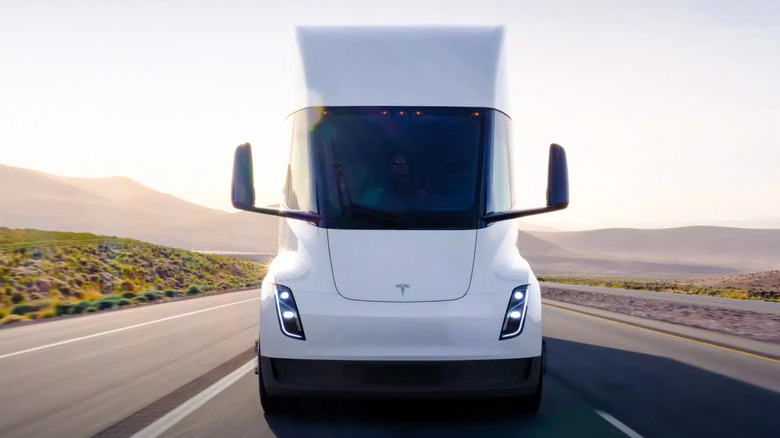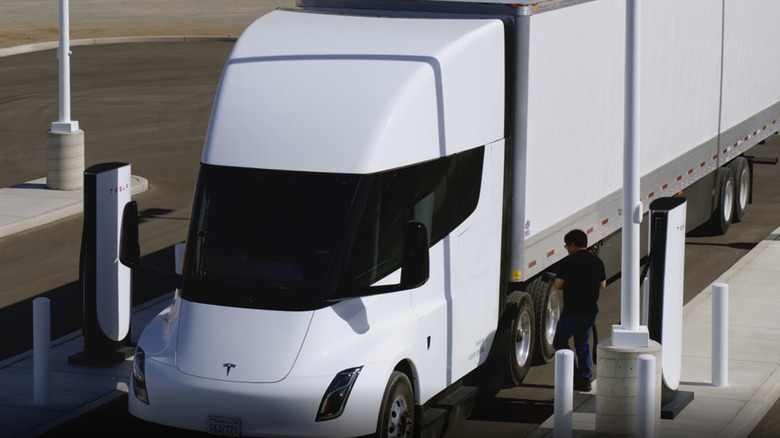Here's How The Tesla Semi Outperforms The Competition In Almost Every Way
With Pepsi finally taking possession of a production model Tesla Semi last month, these long-awaited vehicles are officially out in the wild. When Tesla CEO Elon Musk first announced the heavy-duty truck in 2017, it was expected to go into production by the end of 2019, but, as has been the case with other Tesla products, the timeline was a bit of an overreach and production was met with years of delays. Now that the Tesla Semi is here at last, we can finally find out how it stacks up against the competition in a crowded field.
The Tesla Semi doesn't just compete against offerings from other electric vehicle innovators such as Nikola, BYD, and Lion Electric. It also has to contend with all-electric versions of trucks built by traditional manufacturers including Freightliner, Volvo, Peterbilt, and Kenworth. Luckily for early adopters like Walmart and Budweiser, the Tesla Semi absolutely crushes these other vehicles when you look at the total package.
[1/8] Tesla Semi is 30+% more efficient than competing electric Semi trucks, half the price of most and double the range. Dominating ten-year tech lead. @SawyerMerritt @EmmetPeppers https://t.co/P3V2X5ahSu pic.twitter.com/vlFnv1pp4c
— nextbigfuture (@nextbigfuture) January 1, 2023
Data compiled by Nextbigfuture show that the Tesla Semi's payload capacity of 44,000 pounds is in the same range as other vehicles, but the price estimate is at least $100,000 less than everything else. From a technology perspective, Tesla clearly has the superior battery, boasting the highest efficiency and nearly 150 kWh more capacity than the next largest battery available, not to mention what's easily the shortest charge time of the bunch. And importantly for drivers, nothing else comes close to the Tesla Semi's 1,020 horsepower or 530-mile range.
But I'm not a truck driver
The electrification of semi-trucks most directly impacts truck drivers, transportation companies, and businesses with large vehicle fleets. But if you're thinking that's where the effects stop, think again. Take a lap around your home and consider that nearly everything contained within likely spent at least some time on a semi-truck. Over-the-road transportation is a massive industry, and — even with 3D printers doing some pretty amazing things — it's unlikely we're going to dismantle the entirety of the freight delivery infrastructure any time soon.
While larger vehicles make up only about six percent of road vehicles in the U.S., they generate more than half of vehicle-related particle pollution (via American Lung Association). The electrification of semi-trucks could save an estimated 66,800 lives by 2050 from air quality improvements alone, and the $735 billion saved in public health benefits could fund the purchase of nearly 4 million Tesla Semi 500s at $180,000 each.
Just as Tesla was a primary driver of bringing electric passenger vehicles into the mainstream, its expansion into semis and pickups could help usher in a new era of electric commercial vehicles. And for those looking to order an electric semi-truck today, the choice is clear. The Tesla Semi will carry a typical payload while charging faster and going farther than any of the competition, and it'll put six figures back in your pocket while it does it. Not a bad first entry into this space.

